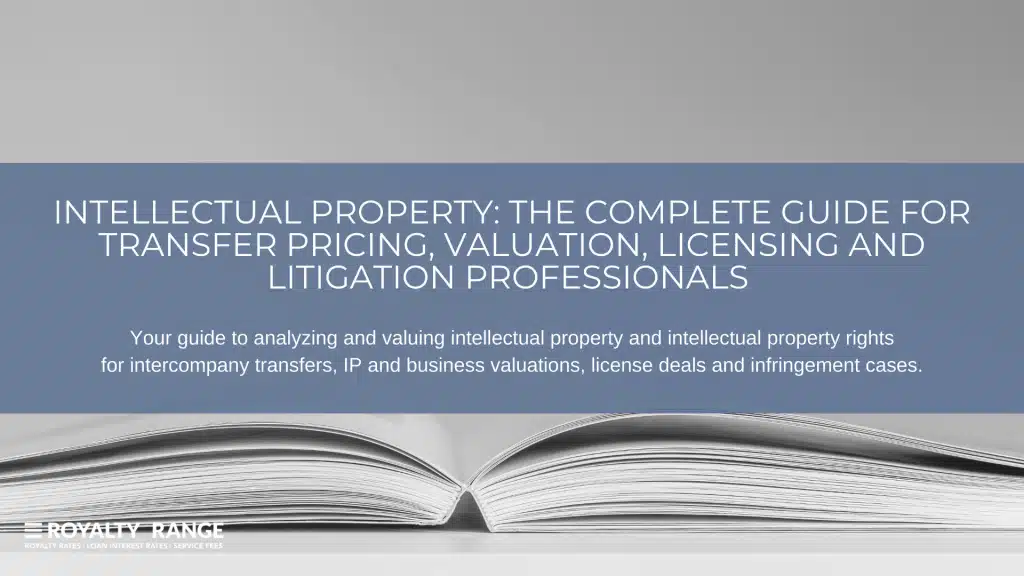Intellectual Property: The complete guide for transfer pricing, valuation, licensing and litigation professionals

Kris (Kestutis) Rudzika |
September 11, 2020

When you are setting transfer prices, carrying out a transfer pricing analysis, valuing intellectual property assets, conducting a business valuation, drafting a licensing agreement or dealing with an infringement case, you need to understand intellectual property. In this guide, we cover everything from what intellectual property is and how it’s protected to how to value it for transfer pricing, valuation, licensing and litigation purposes. We also explain how you can use a royalty rates database to find market data and set benchmarks on the latest intellectual property licenses.
What is intellectual property?
Intellectual property definition: ‘Intellectual property’ refers to intangible assets that are products of the mind. E.g. inventions, brand names, and artistic or technological designs. Intellectual property assets themselves are not physical in nature. Rather, they are the ideas, knowledge and creativity that go into making a product, service, process or business. ‘Intellectual property’ also refers to the legal protection given to these intangible assets to stop others using and damaging them.
Intellectual property is incredibly valuable for businesses as it gives them a competitive edge. That’s why organizations protect intellectual property assets with legal safeguards.

Types of intellectual property protection
There are four main types of intellectual property:
- Patents
- Trademarks
- Copyright
- Trade secrets
These are the intellectual property types that can be legally protected. Having legal protections in place means that the assets can only be used by the party that owns the intellectual property rights – or by parties that have intellectual property rights assigned to them (e.g. in a licensing deal). You can find out more about ownership of intellectual property rights in the next section.

Intellectual property rights definition
The term ‘intellectual property rights’ refers to the right to use an intellectual property asset. If an asset is protected by intellectual property rights, it can only be used by those parties who hold the rights to the intellectual property. This could be the individual or organization that created the intellectual property, or it could be a different party that has been assigned the rights to it. Intellectual property rights are often sold or transferred to other parties in licensing agreements.
The purpose of intellectual property rights is to stop intellectual property being taken and used by other parties. They offer legal protection to the assets and the party that holds the rights to them.

Intellectual property transfer pricing
Intellectual property is a complex issue in transfer pricing. When an intellectual property transfer is carried out between two related entities within an organization, an arm’s length price must be set for taxation purposes. (Being at ‘arm’s length’ means that the rate charged in the transaction is the same as what it would have been if the transaction had occurred between two unrelated parties.)
The difficulty with calculating the cost of intellectual property for transfer pricing is that there are many different variables that affect what should be charged. For example, the intellectual property’s stage of development, the tax regulations in each entity’s country (for multinational enterprises (MNEs)), inflation, the nature of the transaction, and the impact on the various parties.
Transfer pricing methods for intellectual property
There are multiple transfer pricing methods that organizations can use to calculate fair transfer prices for their intellectual property. These include the comparable uncontrolled price (CUP) method, the resale price method, the cost plus method, the transactional net margin method and the transactional profit split method. The most suitable method depends on the circumstances of the transaction and the availability of data. (The Organization for Economic Co-operation and Development (OECD) offers guidance on selecting the most appropriate transfer pricing method.)
The CUP method
According to the OECD, the CUP method is the most direct and reliable transfer pricing method – as long as high-quality comparables data is available. The CUP method involves comparing the cost of the controlled transaction in question with the price charged in a comparable uncontrolled transaction between two unrelated parties. Essentially, it involves using recent market data to determine arm’s length prices for the transfer of intellectual property assets within organizations.
The most important aspect of the CUP method is identifying suitably comparable intellectual property license agreements to analyze. With a royalty rates database like RoyaltyRange, this step is easy. Organizations are able to enter their search criteria and comparability requirements, and RoyaltyRange’s transfer pricing experts will create a detailed report of the most suitable recent license agreements between unrelated parties. Using a database takes away a big chunk of the work and gives organizations confidence that they are analyzing the most reliable data.
CUP analyses and benchmarking studies
If organizations do not have the time, expertise or resources to conduct a CUP analysis themselves, RoyaltyRange can do it for them. A RoyaltyRange benchmarking study provides a full comparison of the most relevant licensing agreements in the database to give organizations a market analysis of their intellectual property. It includes a calculation of the average royalty rate (median) and a market royalty rate range (interquartile range). This provides organizations with an accurate benchmark that they can use to calculate the value of their intellectual property.
DEMPE
Another factor that MNEs must consider when assigning transfer prices for intellectual property is DEMPE. The term ‘DEMPE’ means the development, enhancement, maintenance, protection and exploitation of intangibles. DEMPE was introduced by the OECD in the final Actions 8–10 report of the Transfer Pricing Aspects of Intangibles, which was released on October 5th 2015.
Under DEMPE, organizations must consider how returns are allocated when revenue is generated by an intangible – e.g. an intellectual property asset like a patent. It cannot be assumed that the legal owner of the intellectual property is entitled to the returns in full. Rather, the returns must be allocated according to which parties contributed to the value of the intellectual property. That is, which parties performed functions, used assets and assumed risks in the development, enhancement, maintenance, protection and exploitation of the intangibles or intellectual property.
If you’d like to find out more about DEMPE, discover our DEMPE insights series:
- DEMPE explained
- Identifying intangibles and risks for DEMPE
- The DEMPE functional analysis
- DEMPE functions
- DEMPE: Six steps for analyzing transactions involving intangibles
- DEMPE white paper
- DEMPE analytics tool
Value of intellectual property
Understanding the value of intellectual property is essential for any transaction or analysis involving intellectual property assets. From transfer pricing and business valuations to drafting license deals and dealing with intellectual property rights breaches, knowing the value of an intellectual property asset ensures that organizations receive reasonable compensation for its use. Organizations may also need to know the value of their intellectual property if they are seeking funding, entering into a merger or acquisition, or considering a joint venture arrangement.
Factors affecting the value of intellectual property
The value of intellectual property depends largely on its context, such as the market it will be used in and the age of the asset. An asset’s value is not fixed – it can change in line with a variety of factors. For example, if a brand name has been around for a long time, it may be more valuable than when it first entered the market – especially if it has a good reputation. Alternatively, if the brand has been undergoing hardships in the market, its value may decrease. Activities like marketing can significantly boost the value of an intellectual property asset over time.
Intellectual property valuation methods
There are a number of valuation approaches available for valuing intellectual property. The most suitable method depends on the circumstances of the intellectual property being valued. It can be useful to conduct analyses using multiple methods and cross-checking the results from each.
The most common intellectual property valuation methods are:
- The cost method
- The market value method
- The income method
The cost method of valuing intellectual property
Using a cost-based approach for valuing intellectual property involves basing the asset’s value on the cost of creating or developing it, or the cost of creating or developing a similar asset. These costs may include research and development, materials, labor, testing, trials, overheads, and the cost of protecting the intellectual property. Under this method, the asset’s value comes from the time and money a buyer will save (through not having to develop their own intellectual property), the right to use the protected asset without infringing, and the success of the intellectual property.
The downside of the cost method is that it does not take into account the market potential of the intellectual property, or the asset’s future value. However, it can be a useful way of valuing assets that are in an early stage of development, and that do not currently have market experience.
The market method of valuing intellectual property
The market-based valuation method is similar to the CUP method of transfer pricing. It involves analyzing similar assets that have been licensed in the market, and using this data as a valuation benchmark. The most common difficulty with a market method is finding recent license agreements for similar assets (although this is easy with a royalty rates database like RoyaltyRange).
In order to use this method, organizations need to have access to third-party license agreements that have a high level of comparability. They need to be able to find agreements that are similar in terms of exclusivity, payment structure, territory and market conditions. This is because factors like this can significantly affect the royalty rate charged, which can confuse the valuation analysis.
The easiest and most reliable way to find comparable license agreements is to search the RoyaltyRange database. By applying the search filters for intellectual property type, keywords, exclusivity, territory and date, organizations can ensure that they only see license agreements that are relevant to their valuation requirements. The RoyaltyRange database contains the latest license agreements (with royalty rates) between unrelated parties, gathered from public sources.
The income method of valuing intellectual property
The income method involves valuing intellectual property by considering how much income it could generate in the future (factoring in associated risks and costs). It is important to remember that the income method bases an asset’s value on potential future income, not its past performance. It can be difficult to estimate the intellectual property’s economic life and income over many years.
When carrying out an income-based valuation, organizations need to take into account factors including competition, market and the strength of the intellectual property protection.
Licensing intellectual property
If you are entering into a licensing deal or drafting a license agreement, you will need to determine fair royalty rates for the intellectual property being licensed. This ensures that both parties benefit fairly from the intellectual property rights being granted to the licensee. If the royalty rate is too high, the licensee will be paying too much for the intellectual property, and may reject the licensing deal. If the royalty rate is too low, the licensor will not be fairly compensated for the expertise and time that went into developing the intellectual property. The rate must be calculated accurately.
Royalty rates for intellectual property are usually set as a percentage of revenue. For example, the royalty rate could be 6%, based on net sales and paid on a quarterly basis. This means that, each quarter, the licensee must pay the licensor 6% of the net sales generated by the intellectual property that quarter. Intellectual property royalties can also be set as fixed fees. This means that the licensee must pay the licensor a set amount on a regular basis, regardless of how much income the intellectual property has generated. Royalty percentages are the more common option.
Calculating royalty rates for licensing intellectual property
There are a number of ways to determine fair royalty rates for intellectual property licensing. To get an accurate idea of an asset’s value, it can be useful to look at both market value and development costs. Just as with the valuation and transfer pricing analyses, the most suitable royalty calculation method depends on the individual circumstances of the intellectual property licensing agreement. It is a good idea (but not essential) to try multiple calculation methods and corroborate the results.
A market approach is an effective way of calculating fair royalty rates for intellectual property licensing. This involves looking at the royalty rates charged in comparable licensing agreements, and using these as a basis for your calculation. The most important element of this approach is ensuring that you have access to up-to-date licensing agreements that are comparable to the license agreement that you are drafting – otherwise, the calculation may not be accurate.
Benchmarking royalty rates for intellectual property licensing
If you want to find arms-length royalty rates for your intellectual property in a specific market, the easiest and most reliable option is to invest in a benchmarking study. This calculates a market royalty rate range based on real licensing agreements and your specific search criteria. It is an accurate way to find out what other organizations are charging in similar deals.
When you have a benchmark for your intellectual property, you are able to better understand what would be a fair royalty rate to charge. A benchmarking report also provides you with clear market evidence that will strengthen your position when you begin negotiating royalty rates for the deal.
Intellectual property infringement cases
Intellectual property infringement occurs when a party uses another party’s intellectual property without permission. If a party has not been granted intellectual property rights, they are not allowed to use it in any way. Similarly, intellectual property infringement can occur within licensing agreements. For example, if a licensee uses the intellectual property in a way that was not defined in the scope of the intellectual property licensing agreement, they are in breach of that deal.
In such intellectual property cases, litigation professionals are required to calculate damages for the intellectual property owner. This involves the professional valuing the intellectual property to understand the financial damages caused to the licensor or intellectual property owner.
In patent infringement cases, professionals often calculate a ‘reasonable royalty rate’. This is the royalty that a licensee would pay for the rights to the patented invention in a hypothetical negotiation. If you’d like to find out more about reasonable royalty rates for intellectual property and patent infringement cases, read our article on 3 quick facts about reasonable royalty rates.
Find the latest intellectual property license agreements and royalty rates
Whether you’re setting transfer prices, valuing intangible assets, drafting a licensing agreement or dealing with an infringement case, you can use the RoyaltyRange database to find the latest intellectual property licensing data. To get started, search the database using One Search (and get a full royalty rates report) or order a benchmarking study (including a royalties average and range).
Request One Search
We will perform the search and deliver the initial results within hours, at no cost.




